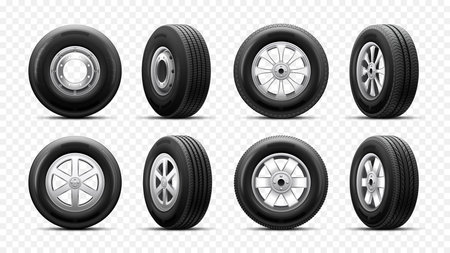Introduction to Run-Flat and Regular Tires
When it comes to keeping your vehicle rolling safely and efficiently, the type of tires you choose plays a crucial role. For American drivers navigating everything from bustling city streets to scenic highways, understanding the differences between run-flat tires and regular tires is more important than ever. Run-flat tires, first developed for military and high-performance vehicles in the 1980s, are engineered to keep you moving even after a puncture—offering up to 50 miles of continued driving at reduced speeds. Regular tires, meanwhile, have been the standard since automobiles hit U.S. roads, valued for their comfort and affordability but requiring immediate attention when damaged. Today, with evolving road conditions and a growing emphasis on safety, convenience, and sustainability, choosing between these two options is more than a technical decision—it’s about aligning with your daily needs and eco-conscious values.
2. Performance and Safety on the Road
When considering run-flat tires versus regular tires for everyday driving in the U.S., performance and safety are top priorities for commuters, families, and road trip enthusiasts alike. Both tire types offer distinct advantages depending on your daily needs, driving style, and typical road conditions.
Comparison of Safety Features
| Tire Type | Safety During Puncture | Handling & Stability |
|---|---|---|
| Run-Flat Tires | Allows you to drive up to 50 miles at reduced speeds after a puncture—no need to pull over immediately, which is safer on busy highways or in unsafe areas. | Generally stiffer sidewalls may reduce comfort but enhance control during emergencies. |
| Regular Tires | Loses air rapidly during a puncture—immediate action required, which can be risky in traffic or remote locations. | Softer ride quality and better shock absorption on city streets; however, handling may be compromised if a flat occurs suddenly. |
Reliability in Everyday Scenarios
- Urban Driving: Run-flats shine in stop-and-go city traffic where quick access to repair shops isn’t always guaranteed. Regular tires provide a smoother ride on pothole-ridden streets but require more vigilance regarding tire pressure.
- Highway Commutes: Safety is crucial at higher speeds. Run-flats minimize the danger of blowouts by maintaining shape after a puncture, allowing safe travel to the nearest service station. Regular tires, while quieter and more comfortable, leave drivers vulnerable to sudden flats.
- Road Trips: For long journeys across varied terrain, run-flat tires offer peace of mind with extended mobility after minor damage. Regular tires may provide better fuel economy due to lighter weight but necessitate carrying a spare or repair kit for emergencies.
Quick Reference Table: Everyday Reliability
| Scenario | Run-Flat Tires | Regular Tires |
|---|---|---|
| City Streets | No immediate change needed after minor punctures; less downtime. | Smoother ride but requires prompt attention if punctured. |
| Freeways | Continued safe operation post-puncture; reduces stress during commutes. | Puncture could mean sudden stops or delays; potential safety risk. |
| Long-Distance Travel | No need for spare tire; enhanced convenience and security. | Spares or repair kits essential; possible trip interruptions from flats. |
Sustainability Note:
If eco-friendly driving matters to you, remember that regular tires typically weigh less and may offer improved fuel efficiency, while run-flats reduce waste associated with discarded spare tires and emergency roadside calls. Each choice impacts your personal carbon footprint and driving experience differently—choose what aligns best with your lifestyle and sustainability goals.

3. Cost, Maintenance, and Longevity
When American drivers compare run-flat tires to regular tires, cost is often a primary consideration. Run-flat tires typically come with a higher initial price tag—sometimes up to 50% more than standard tires. This upfront investment reflects their reinforced sidewalls and advanced technology that allow continued driving after a puncture. On the other hand, regular tires are more budget-friendly at purchase, making them appealing for drivers focused on minimizing short-term expenses.
However, it’s not just about the sticker price. Maintenance needs can also differ between these tire types. Run-flat tires are designed to get you safely to a repair shop after a puncture, but once damaged, they often can’t be repaired and must be replaced entirely. Regular tires are more frequently repairable after minor damage, helping keep ongoing maintenance costs lower in some cases.
When it comes to longevity, American drivers have noticed that run-flat tires tend to wear out faster than regular tires—often by 6,000–10,000 miles less on average. This is partly due to their stiffer construction and heavier weight. As a result, despite their added safety convenience, the total cost of ownership over several years may end up being higher for run-flats when factoring in more frequent replacements.
For everyday driving across diverse American road conditions—from city streets to rural highways—the value equation depends on your priorities: whether you prize peace of mind and safety or long-term savings and flexibility in tire repairs. Carefully weighing initial investment against expected lifespan and maintenance requirements is key for making the best choice for your driving lifestyle.
4. Convenience and Peace of Mind
When it comes to daily commuting, weekend getaways, or the classic American cross-country road trip, convenience and peace of mind are top priorities for many drivers. Run-flat tires offer a unique advantage in these areas compared to regular tires, especially given the vastness of U.S. highways and the popularity of remote travel destinations.
How Do Run-Flat Tires Enhance Convenience?
Run-flat tires are engineered to allow you to keep driving even after a puncture—typically up to 50 miles at reduced speeds. This means you don’t have to immediately pull over on a busy freeway or in an unfamiliar rural area to change a flat tire. Instead, you can safely reach a service station or your destination, minimizing disruption to your plans.
Peace of Mind for Road Trips and Long Drives
For American drivers who love exploring national parks, scenic byways, or embarking on long-distance journeys, run-flats provide reassurance. The thought of being stranded on a remote stretch of road is unsettling, but with run-flat technology, you’re much less likely to be caught off guard by unexpected tire trouble far from help.
Convenience Comparison Table
| Feature | Run-Flat Tires | Regular Tires |
|---|---|---|
| Immediate Drivability After Puncture | Yes (up to 50 miles) | No (requires spare or roadside assistance) |
| Need for Spare Tire | No | Yes (or repair kit) |
| Impact on Travel Plans | Minimal Disruption | Potential Delays |
Sustainable Travel Considerations
While run-flat tires may weigh slightly more and sometimes impact fuel efficiency, their ability to avoid roadside breakdowns aligns with the American preference for seamless travel experiences and personal safety—critical factors for families, solo travelers, and eco-conscious adventurers alike.
5. Environmental Impact and Sustainability
As American drivers become increasingly eco-conscious, understanding the environmental footprint of run-flat tires versus regular tires is essential. Both tire types present unique sustainability challenges and opportunities, but their differences are worth a closer look for those seeking greener automotive solutions.
Materials and Manufacturing
Run-flat tires are generally constructed with reinforced sidewalls and specialized compounds to support driving after a puncture. While this means increased durability, it often requires additional synthetic materials and energy-intensive manufacturing processes compared to regular tires. In contrast, traditional tires use fewer materials overall, which can reduce their initial carbon footprint during production.
Recyclability and Disposal
Tire recycling remains a challenge in the U.S., but efforts are growing to address end-of-life impacts. Regular tires benefit from established recycling streams, making them easier to repurpose into products like playground surfaces or construction materials. Run-flat tires, due to their complex structure and added reinforcements, are more difficult to recycle—potentially leading to higher landfill rates unless industry advancements catch up.
Alignment with Eco-Friendly Trends
With the U.S. market steadily moving toward electric vehicles (EVs) and sustainable transportation, tire manufacturers are innovating greener options for both categories. Some run-flat models now incorporate eco-friendly rubber blends or bio-based materials, aiming to reduce petroleum dependency. Meanwhile, regular tire producers emphasize rolling resistance improvements for better fuel economy—a win-win for drivers seeking lower emissions.
Ultimately, while both run-flat and regular tires have room for improvement regarding environmental impact, consumers should prioritize brands that promote transparency about sourcing, manufacturing practices, and recyclability. Making informed choices aligns everyday driving with America’s commitment to a cleaner, greener future.
6. Practical Considerations for American Drivers
When choosing between run-flat tires and regular tires, American drivers should weigh several practical factors rooted in daily life, diverse weather, and road conditions across the country. The best choice depends on your driving habits, local climate, and what you need from your vehicle—whether that’s the convenience of city commuting, reliability for family road trips, or ruggedness for outdoor adventures.
Understanding Your Driving Environment
Urban Commuters: If you mostly drive in cities or suburbs with well-maintained roads and quick access to repair shops, run-flat tires offer peace of mind. You can keep moving after a puncture without waiting for roadside assistance—perfect for busy schedules.
Long-Distance Travelers: For families or professionals who clock serious highway miles or take cross-country trips, consider the availability of run-flat tire replacements on your routes. While the self-supporting feature is great for safety, not every town stocks these tires, which could lead to longer waits if you need a replacement.
Weather Patterns Matter
The U.S. faces everything from icy winters in the Midwest to scorching summers in the Southwest. Regular tires come in a broader range of options—including specialized all-season, winter, and summer models—making it easier to tailor your setup to local weather. Run-flats are catching up but still have fewer seasonal options.
Lifestyle Needs: Outdoor Enthusiasts vs. Daily Drivers
If weekend hiking trips or camping are part of your routine, remember that run-flat tires may not perform as well off-road due to their stiffer sidewalls. Standard tires typically offer better grip and ride comfort on rough terrain. However, if you prioritize never getting stranded far from help, run-flats might still be worth considering.
Tips for Choosing the Right Tire
- Assess your local infrastructure: If repair shops are scarce or roadside services unreliable, having run-flats can be a game-changer.
- Consider climate: Opt for regular tires if you need specific performance (e.g., snow traction), but check if suitable run-flats are available for your region.
- Factor in vehicle compatibility: Some new cars, especially luxury models, are designed specifically for run-flat tires—switching to regular ones may require additional equipment like a spare tire kit.
- Evaluate sustainability goals: Reducing waste is key; regular tires may last longer depending on driving style and maintenance, while run-flats can help avoid unsafe roadside tire changes that sometimes lead to improper disposal.
Ultimately, there’s no one-size-fits-all answer. Take stock of your unique needs and the environment you drive in most often—then select the tire type that helps keep your journeys safe, smooth, and sustainable on America’s varied roads.
7. Conclusion: Making the Right Choice
Choosing between run-flat tires and regular tires is more than a simple swap at the auto shop—it’s about balancing safety, convenience, cost, and sustainability in your daily drive. Run-flat tires offer peace of mind, letting you keep moving after a puncture and reducing the need for roadside assistance. However, they often come with a higher price tag, can impact ride comfort, and may wear out faster than their traditional counterparts. On the other hand, regular tires are typically more affordable and provide a smoother ride but require immediate attention in case of flats.
For American drivers—whether you’re commuting across town or setting out on a cross-country road trip—the best choice depends on your lifestyle, driving conditions, and priorities. Are you looking for ultimate convenience and safety in emergencies, or do you prioritize comfort and long-term value? Whichever route you take, consider options that support sustainable manufacturing practices and responsible disposal to reduce environmental impact. By weighing the pros and cons of both tire types and making an informed decision, you’ll be supporting not just your own journey but also a greener future for everyone on the road.


